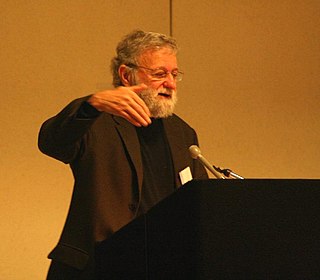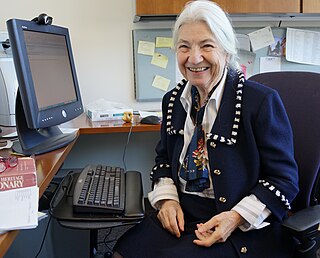External links
| This biographical article relating to a computer specialist is a stub. You can help Wikipedia by expanding it. |
Thomas P. Moran is a Distinguished Engineer at the IBM Almaden Research Center in San Jose, California. He has been active in the field of human computer interaction for a very long time. In 1983 the book he wrote along with Stuart Card and Allen Newell The Psychology of Human-Computer Interaction was published. It became a very influential book in the field, partly for introducing the Goals, Operators, Methods, and Selection rules (GOMS) model.
He founded and has been Editor-in-Chief of Human-Computer Interaction, one of the leading journals of the field.
He is one of the first CHI Academy members and won ACM SIGCHI's 2004 Life Time Achievement Award. In 2003 he was inducted as a Fellow of the Association for Computing Machinery. In 2008 he was elected as a Fellow of AAAS.
Unrelated to the other famous engineer, Thomas D. Moran.
| This biographical article relating to a computer specialist is a stub. You can help Wikipedia by expanding it. |

Frederick Phillips "Fred" Brooks Jr. is an American computer architect, software engineer, and computer scientist, best known for managing the development of IBM's System/360 family of computers and the OS/360 software support package, then later writing candidly about the process in his seminal book The Mythical Man-Month. Brooks has received many awards, including the National Medal of Technology in 1985 and the Turing Award in 1999.

Donald Arthur Norman is an American researcher, professor, and author. Norman is the director of The Design Lab at University of California, San Diego. He is best known for his books on design, especially The Design of Everyday Things. He is widely regarded for his expertise in the fields of design, usability engineering, and cognitive science. He is a co-founder and consultant with the Nielsen Norman Group. He is also an IDEO fellow and a member of the Board of Trustees of IIT Institute of Design in Chicago. He also holds the title of Professor Emeritus of Cognitive Science at the University of California, San Diego. Norman is an active Distinguished Visiting Professor at the Korea Advanced Institute of Science and Technology (KAIST), where he spends two months a year teaching.
GOMS is a specialized human information processor model for human-computer interaction observation that describes a user's cognitive structure on four components. In the book The Psychology of Human Computer Interaction. written in 1983 by Stuart K. Card, Thomas P. Moran and Allen Newell, the authors introduce: "a set of Goals, a set of Operators, a set of Methods for achieving the goals, and a set of Selections rules for choosing among competing methods for goals." GOMS is a widely used method by usability specialists for computer system designers because it produces quantitative and qualitative predictions of how people will use a proposed system.

Ben Shneiderman is an American computer scientist, a Distinguished University Professor in the University of Maryland Department of Computer Science, which is part of the University of Maryland College of Computer, Mathematical, and Natural Sciences at the University of Maryland, College Park, and the founding director (1983-2000) of the University of Maryland Human-Computer Interaction Lab. He conducted fundamental research in the field of human–computer interaction, developing new ideas, methods, and tools such as the direct manipulation interface, and his eight rules of design.
In human–computer interaction, the keystroke-level model (KLM) predicts how long it will take an expert user to accomplish a routine task without errors using an interactive computer system. It was proposed by Stuart K. Card, Thomas P. Moran and Allen Newell in 1980 in the Communications of the ACM and published in their book The Psychology of Human-Computer Interaction in 1983, which is considered as a classic in the HCI field. The foundations were laid in 1974, when Card and Moran joined the Palo Alto Research Center (PARC) and created a group named Applied Information-Processing Psychology Project (AIP) with Newell as a consultant aiming to create an applied psychology of human-computer interaction. The keystroke-level model is still relevant today, which is shown by the recent research about mobile phones and touchscreens.
Stuart K. Card, an American researcher and retired Senior Research Fellow at Xerox PARC, is considered to be one of the pioneers of applying human factors in human–computer interaction. His study of input devices led to the Fitts's Law characterization of the computer mouse and was a major factor leading to the mouse's commercial introduction by Xerox, most notably in the Alto and Star projects, some of the very earliest GUI systems employing a desktop metaphor. The 1983 book The Psychology of Human-Computer Interaction, which he co-wrote with Thomas P. Moran and Allen Newell, became seminal work in the HCI field. Further research into the theoretical characterizations of human–machine interaction led to developments like "the Model Human Processor, the GOMS theory of user interaction, information foraging theory, and statistical descriptions of Internet use". In the new millennium his research has been focusing on developing a "supporting science of human–information interaction and visual-semantic prototypes to aid sense making".
Human processor model or MHP is a cognitive modeling method developed by Stuart K. Card, Thomas P. Moran, & Allen Newell (1983) used to calculate how long it takes to perform a certain task. Other cognitive modeling methods include parallel design, GOMS, and keystroke-level model (KLM).

Paul Dourish is a computer scientist best known for his work and research at the intersection of computer science and social science. Born in Scotland, he is a professor of Informatics at the University of California, Irvine, where he joined the faculty in 2000. He is a Fellow of the ACM, and winner of the CSCW 2016 "Lasting Impact" award. Dourish has published three books and over 100 scientific articles, and holds 19 US patents.
Ekaterini Panagiotou Sycara is Edward Fredkin Research Professor of Robotics in the Robotics Institute, School of Computer Science at Carnegie Mellon University internationally known for her research in artificial intelligence, particularly in the fields of negotiation, autonomous agents and multi-agent systems. She directs the Advanced Agent-Robotics Technology Lab at Robotics Institute, Carnegie Mellon University. She also serves as academic advisor for PhD students at both Robotics Institute and Tepper School of Business.
John Millar Carroll is a distinguished professor of Information Sciences and Technology at Pennsylvania State University, where he previously served as the Edward Frymoyer Chair of Information Sciences and Technology. Carroll is perhaps best known for his theory of Minimalism in computer instruction, training, and technical communication.

Brian R. Gaines is a British scientist, engineer, and Professor Emeritus at the University of Calgary.

Jonathan Grudin is a principal design researcher at Microsoft and affiliate professor at the University of Washington Information School working in the fields of human-computer interaction (HCI) and computer-supported cooperative work (CSCW). Grudin is a pioneer of the field of CSCW and one of its most prolific contributors. His collaboration distance to other HCI researchers has been described by the Grudin number. Grudin is also well known for the Grudin Paradox or Grudin Problem, which states basically with respect to the design of collaborative software for organizational settings, "What may be in the managers' best interests may not be in the interests of individual contributors, and therefore not used." He was awarded the inaugural CSCW Lasting Impact Award in 2014 on the basis of this work. He has also written about the publication culture and history of HCI. His book From Tool to Partner, The Evolution of Human-Computer Interaction was published in 2017.

Ruzena Bajcsy is an American engineer and computer scientist who specializes in robotics. She is Professor of Electrical Engineering and Computer Science at the University of California, Berkeley, where she is also Director Emerita of CITRIS.
Human–computer interaction (HCI) studies the design and use of computer technology, focused on the interfaces between people (users) and computers. Researchers in the field of HCI observe the ways in which humans interact with computers and design technologies that let humans interact with computers in novel ways.
Steve Whittaker is a Professor in Human-Computer Interaction.

Robert E. Kraut is an American social psychologist who studies human-computer interaction, online communities, internet use, group coordination, computers in organizations, and the role of visual elements in interpersonal communication. He is a Herbert Simon Professor of Human-computer Interaction at the Human-Computer Interaction Institute at Carnegie Mellon University.

Human factors and ergonomics is the application of psychological and physiological principles to the engineering and design of products, processes, and systems. The goal of human factors is to reduce human error, increase productivity, and enhance safety and comfort with a specific focus on the interaction between the human and the thing of interest.
Victoria Bellotti is a user experience manager for growth at Lyft. Previously, she was a research fellow at the Palo Alto Research Center. She is known for her work in the area of personal information management and task management, but from 2010 to 2018 she began researching context-aware peer-to-peer transaction partner matching and motivations for using peer-to-peer marketplaces which led to her joining Lyft. Victoria also serves as an adjunct professor in the Jack Baskin School of Engineering at University of California Santa Cruz, on the editorial board of the Personal and Ubiquitous Computing and as an associate editor for the International Journal of HCI. She is a researcher in the Human–computer interaction community. In 2013 she was awarded membership of the ACM SIGCHI Academy for her contributions to the field and professional community of human computer interaction.

Pascale Fung (馮雁) is a professor in the Department of Electronic & Computer Engineering and the Department of Computer Science & Engineering at the Hong Kong University of Science & Technology(HKUST). She is the director of the newly established, multidisciplinary Centre for AI Research (CAiRE) at HKUST. She is an elected Fellow of the Institute of Electrical and Electronics Engineers (IEEE) for her “contributions to human-machine interactions” and an elected Fellow of the International Speech Communication Association for “fundamental contributions to the interdisciplinary area of spoken language human-machine interactions”.
Daniel Mier Gusfield is an American computer scientist, Distinguished Professor of Computer Science at the University of California, Davis. Gusfield is known for his research in combinatorial optimization and computational biology.